What is whooping cough?
Pertussis, or whooping cough, is an infectious respiratory disease caused by the bacterium Bordetella pertussis. It is transmitted by airborne droplets released from the nose and throat of an infected person while coughing, sneezing, or talking.

The history of the study of pertussis dates back to ancient times, although the first documented descriptions of the disease appeared in the 15th century. The disease has remained a significant public health problem for centuries, especially among children.
One of the most important moments in the history of pertussis research was the discovery of its causative agent, the bacterium Bordetella pertussis. This microorganism was first isolated and described in 1906 by French bacteriologist Jules Bordet and his colleague Octavio Morax (Octave Gengou). The discovery of this bacterium was a key moment in understanding the causes and mechanisms of the disease.
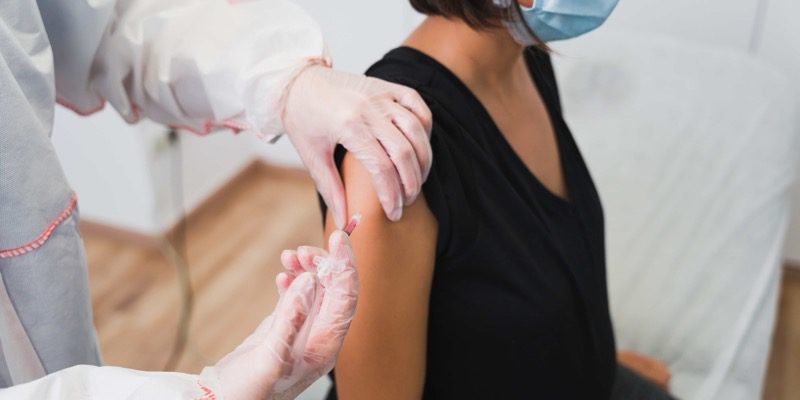
Vaccines against pertussis were developed in the 20th century, which significantly reduced the prevalence and severity of the disease. Modern vaccines are widely used in the immunization program and help protect children and adults.
- Prevalence and relevance of the disease
Whooping cough remains a pressing public health problem despite existing vaccination. Although the number of infections has decreased due to vaccination, there are still regions where the disease remains prevalent. In addition, in some cases, there has been an increase in the number of cases due to decreased immunity of vaccinated persons or inadequate vaccination coverage.
- Age group at risk
The greatest vulnerability to pertussis is in young children, especially infants. Children under two years of age are most susceptible to severe forms of the disease and its complications. However, pertussis can also occur in adolescents and adults, especially those who have not been fully immunized or whose immune systems are weakened.
Whooping cough: incubation period of the disease
The incubation period of pertussis, that is, the time from the moment of infection to the appearance of the first symptoms, is usually about 7-10 days. However, the incubation period can vary depending on individual characteristics of the body, the state of the immune system and other factors. In some people, the incubation period can last up to 21 days. It is important to remember that the contagiousness of pertussis begins during the incubation phase, so it is important to take preventive measures even if potentially infected persons are asymptomatic.
Bordetella pertussis as a cause of disease
Bordetella pertussis is the bacterial agent that is the primary cause of pertussis. This Gram-positive bacterium can only affect humans and cause inflammation in the upper respiratory tract. Bordetella pertussis releases toxins that provoke the development of inflammation and coughing fits. These toxins interfere with the normal function of the cilia of the respiratory epithelium, which leads to mucus accumulation and causes the characteristic symptoms of pertussis. Understanding the role of Bordetella pertussis in the development of the disease helps in the development of effective treatment and prevention methods.
The highly contagious nature of pertussis
Whooping cough is a highly contagious disease that can be transmitted by airborne droplets. Active inflammation of the mucous membranes of the respiratory system, severe coughing and copious sputum production contribute to the active spread of the pathogen. Transmission occurs only through direct contact with an infected person at a distance of no more than 2 meters. This explains why pertussis spreads so rapidly in high-density areas such as schools and kindergartens. Understanding the mechanism of transmission emphasizes the importance of isolating patients and following preventive measures to prevent the spread of the disease.
Whooping cough: symptoms in adults and children
The symptoms of whooping cough can manifest themselves as a dry cough, with attacks that can last up to 14 days, as well as a spasmodic cough that causes discomfort and difficulty in breathing. It is important to consider the possibility of secondary infection and its complications, so timely contact with a doctor plays a key role in successful treatment.
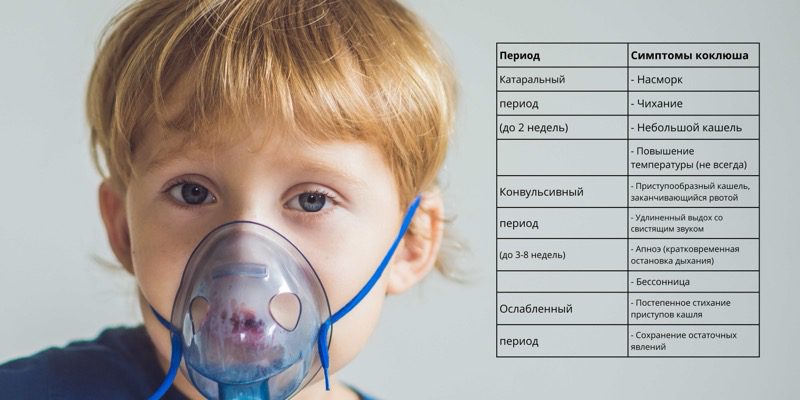
Signs of whooping cough may include:
| Period | Symptoms |
|---|---|
| catarrhal | Runny nose |
| period | Sneezing |
| (up to 2 weeks) | A little dry cough |
| Fever (not always) | |
| Convulsive | A spasmodic cough that ends in vomiting |
| period | A long exhalation with a whistling sound. |
| (up to 3-8 weeks) | Apnea (short-term respiratory arrest) |
| Insomnia | |
| Weakened | Gradual subsiding of coughing fits |
| period | Persistence of residual effects |
Causes of Whooping Cough
Here are the main causes of whooping cough:
- Under-vaccination: One of the main causes of pertussis is inadequate or incomplete vaccination against the disease. Despite widespread vaccination, some people do not receive the required vaccinations or do not complete the full course of vaccinations.
- Spread of infection: Whooping cough is spread from a sick person to a healthy person through droplets that are spread during coughing, sneezing, or talking. It is especially dangerous for children and infants whose immune systems are not yet fully developed.
- Weakened immune system: People with weakened immune systems or co-morbidities are more susceptible to whooping cough. This can be caused by various factors such as stress, lack of sleep, poor diet or the presence of other infections.
- Contact with a sick person: Close contact with a person with pertussis increases the risk of contracting the disease. This is especially true in home settings or places with large concentrations of people, such as daycare centers or schools.
- Under-vaccination of adults: Although vaccinations are usually given during childhood, adults can also experience pertussis due to under-vaccination or loss of immunity over time.
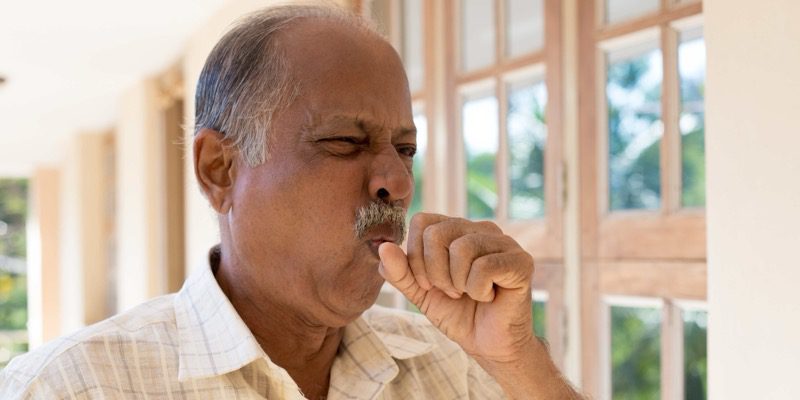
Complications of whooping cough
Complications can be serious and even dangerous to your health. Here are some of them:
- Pneumonia: Pneumonia, or inflammation of the lungs, can develop as a complication of whooping cough due to a secondary bacterial infection. It is a serious condition that requires medical intervention and antibiotic treatment.
- Otitis media: Otitis media, or inflammation of the ear, can also occur as a complication of whooping cough, especially in children. It occurs because the infection spreads from the upper respiratory tract to the ear.
- Encephalitis: Encephalitis, or inflammation of the brain, can be a rare but serious complication of whooping cough. This condition can lead to headaches, seizures, impaired brain function, changes in consciousness, and other serious consequences.
- Seizures: Whooping cough can cause seizures in children and adults due to lack of oxygen to the brain as a result of coughing fits and apnea.
- Pulmonary atelectasis: Pulmonary atelectasis, or collapse of lung tissue, can occur due to incomplete ventilation of the lungs during coughing fits. This can lead to impaired gas exchange and an increased risk of other complications such as pneumonia.
These complications emphasize the importance of timely diagnosis and treatment of pertussis, as well as the need to prevent the disease through vaccination. If you or your child develops symptoms of pertussis, it is important to see your doctor for evaluation and appropriate treatment to prevent possible complications.
Whooping cough diagnosis
Diagnosing whooping cough involves several steps that help establish an accurate diagnosis and start proper treatment. Here are the main methods for diagnosing whooping cough:
- Doctor’s Exam: The doctor examines the patient and identifies the characteristic symptoms of whooping cough, such as whooping cough and shortness of breath.
- History taking: The physician elicits information from the patient or parents about contact with pertussis patients, immunization status, and patterns of disease manifestations.
- Bacteriologic sputum culture: This method detects the presence of Bordetella pertussis in the patient’s sputum. A sputum sample is collected and sent to a laboratory for analysis.
- PCR diagnosis: Polymerase chain reaction (PCR) is used to detect the presence of Bordetella pertussis DNA in sputum or other biological materials.
- Serologic blood test: This method detects antibodies to the bacterium Bordetella pertussis in the patient’s blood. Antibody levels can help confirm the diagnosis of pertussis.
- Lung X-ray: Occasionally, a lung X-ray may be performed to look for signs of pneumonia or other complications of pertussis.
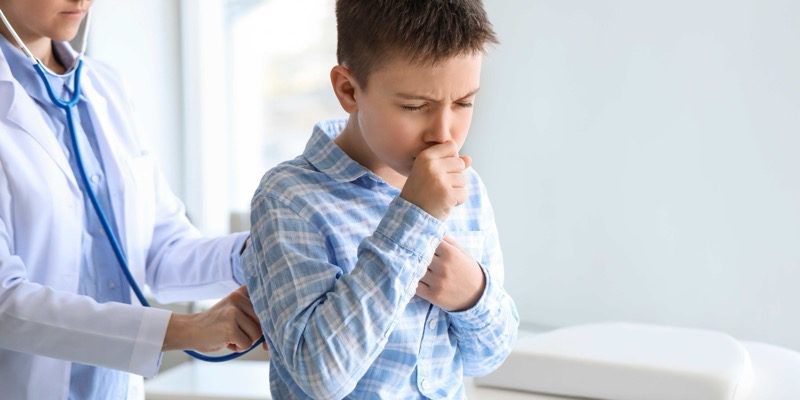
Whooping cough treatment at the clinic
An important aspect in the fight against pertussis is its treatment. This is especially true for older people, who may have complications in the form of inflammation of the upper respiratory tract and damage to the nervous system. The main treatment for pertussis is the use of antibiotics to fight the bacteria and relieve symptoms. It is important to start treatment as early as possible to prevent complications from developing.
Treatment of pertussis often involves a comprehensive approach that combines several therapies. Here are the main types of treatment that may be prescribed by a doctor:
- Antimicrobial therapy: This includes taking broad-spectrum antibiotics to prevent the bacteria from spreading further in the body and reduce the risk of complications. This treatment helps reduce the number of Bordetella pertussis bacteria in the body and speed recovery.
- Therapy to relieve symptoms: Includes the use of cough suppressants, mucolytics and antispasmodics to reduce the frequency and intensity of coughing and to facilitate breathing. Humidification of the air also plays an important role in alleviating mucosal irritation of the upper respiratory tract.
- Humidifying the air and ventilating the room: These methods help to improve indoor air quality, reduce the concentration of viruses and bacteria, and alleviate irritation of the mucous membranes of the respiratory tract.
- Drink plenty of fluids to prevent dehydration and help the body flush out toxins.
- Administration of pertussis immunoglobulin (PKI): If necessary, PKI may be given, especially in newborns and infants, to prevent severe disease.
- Oxygen therapy: If necessary, the doctor may prescribe oxygen therapy to ensure adequate oxygen levels in the body, especially if the patient is having difficulty breathing.
This comprehensive approach helps manage whooping cough by alleviating symptoms and speeding up the healing process.
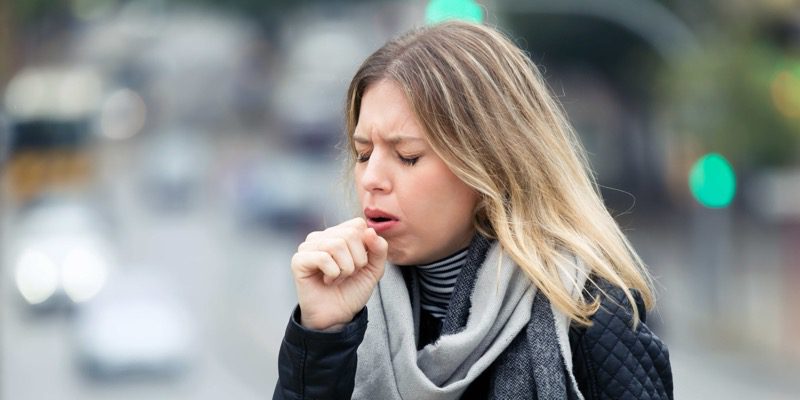
Prevention of whooping cough
Because the disease is airborne, vaccination is key to preventing its spread. It is recommended that children should be vaccinated between 6 months and 7 years of age and repeated at intervals, e.g. 4 weeks after the first vaccination. This protects not only the children themselves but also those around them from pertussis.
Prevention plays a key role in preventing the spread of this disease. Here are the main methods of prevention:
- Vaccination: One of the most effective ways to prevent pertussis. Vaccination is given with DPT (acellular, pertussis, diphtheria, tetanus) or DPT-Hib (a component against Haemophilus influenzae is added). Vaccination is recommended for children in early childhood and can also be given in adults, especially those at risk.
- Isolation of the patient: If pertussis is suspected, it is important to isolate the patient from others to prevent transmission to others. This is especially important in case of contact with children and infants, who have a higher risk of developing severe pertussis.
- Quarantine measures: When cases of pertussis occur in crowded areas such as daycare centers, schools, or health care facilities, quarantine measures may be implemented. This may include temporarily closing facilities or limiting contact with sick people to prevent the spread of infection.
Interesting facts about whooping cough:
- Whooping cough has been known since ancient times and was described as a “dry cough”.
- The word “whooping cough” comes from the Greek word “kokhux,” which means “wheeze.”
- Whooping cough is known for its attack-like cough, which can become so severe that it causes vomiting.
- Most deaths from pertussis occur in newborns and infants, especially in countries with low access to health care.
- Whooping cough is easily transmitted from person to person through coughing, which carries the infection by airborne droplets.
- Since the introduction of pertussis vaccination in developed countries, mortality from the disease has decreased significantly.

Frequently Asked Questions (FAQ)
1. How often should I be immunized against pertussis?
- It is recommended that you be immunized against pertussis according to the immunization schedule for infants and children.
2. Can I get whooping cough if I have been vaccinated?
- Vaccination does not guarantee complete protection, but it does reduce the risk of disease and its severity.
3. What possible complications can occur with whooping cough?
- Complications of whooping cough can include pneumonia, seizures, breathing problems, and even death, especially in infants.
4. How long is the period of contagiousness in whooping cough?
- The period of contagiousness usually lasts until the first 2 weeks of antibiotic treatment.
5. Can I use over-the-counter cough medicines for whooping cough?
- It is important to consult your doctor before using any medication, including cough suppressants.
6. How to recognize pertussis in a child?
- Whooping cough: symptoms of pertussis in children are coughing fits, especially at night, intermittent breathing and a characteristic “hoarse” sound when breathing in.
7. How to treat whooping cough in adults at home?
- When an adult has whooping cough, warm drinks, wet compresses, cough syrups and other methods can be used, but it is important to consult your doctor before starting treatment.
8. How to treat pertussis in children?
- Whooping cough: treatment in children usually includes antibiotics, symptomatic drugs to relieve cough and other manifestations of the disease, as well as compliance with the regime and recommendations of the doctor.
9. How is pertussis transmitted?
- Whooping cough is transmitted through droplets secreted from the nose and throat of an infected person when coughing, sneezing, or talking.
10. Whooping cough: how long is the incubation period?
- The incubation period of pertussis usually lasts 7 to 10 days, but can be longer.
11. Can pregnant women be immunized?
- Yes, health experts recommend whooping cough vaccination for women between 27 and 36 weeks of pregnancy. This not only helps protect the pregnant woman herself from the disease, but also provides a level of protection for the baby in the first few months of life.
Important:
- The information provided in this article does not constitute medical advice.
- Coolaser Clinic does not provide treatment for this condition.
- You should always consult your doctor before using any methods of treatment or prevention of whooping cough.
Coolaser Clinic reminds you that this disease can lead to serious consequences, especially in children. The most important thing to know about pertussis is the symptoms and diagnosis of the disease.
Sources:







